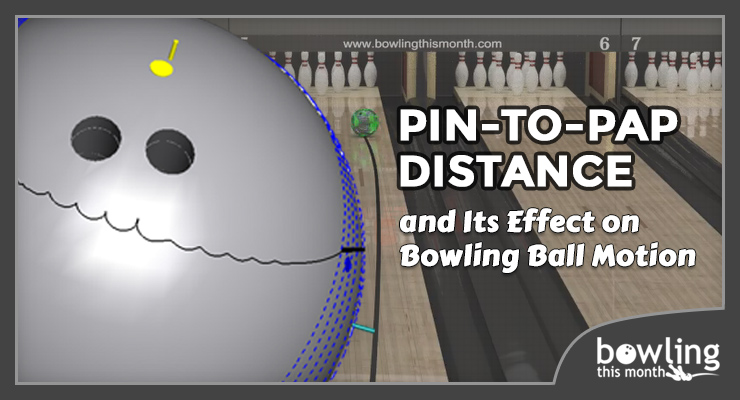Pin-to-PAP distance is one of the dozens of factors that can affect the on-lane motion of a bowling ball. It is defined as the distance, measured along the surface of the ball, from the bowler’s positive axis point (PAP) to the ball’s pin, where:
- the PAP is the point on the ball’s surface that denotes the location of the axis about which the ball rotates at the release, and
- the pin is the marking on the surface of the ball that indicates the location of the top of the core; in most cases, this marking is very close to the ball’s low RG axis.
Pin-to-PAP distance is typically expressed in units of inches and usually measures somewhere between 0 inches and 6 inches. The image below shows some examples of various pin-to-PAP distances in a model of a drilled bowling ball.
In these images, the yellow circle is the pin and the small black cylinder represents the axis of the PAP. The pin-to-PAP distances shown are 2 inches (left), 4 inches (middle), and 6 inches (right).
The effect of pin-to-PAP distance
Pin-to-PAP distance is one element of a bowling ball’s layout. The layout, of course, defines how the core is oriented inside the ball relative to the bowler’s PAP and relative to the gripping holes.
We’re often told two main things about how pin-to-PAP distance affects ball motion. First, the conventional wisdom says that pin-to-PAP distance determines how much track flare the ball will have because it determines how “stable” or “unstable” the core is at the point of release. This line of thinking goes as follows:
- If the pin is placed close to the PAP, then the core is in a “stable” orientation and, therefore, the ball won’t flare very much.
- If the pin is placed so the core is oriented at an angle to the PAP, then it is in an “unstable” orientation and, therefore, the ball will flare significantly. The distance that is often referred to as the most “unstable” is 3.375 inches, as this is the pin distance that orients the core at a 45 degree angle to the PAP.
- If the pin is placed far from the PAP (specifically, 6.75 inches from the PAP—90 degrees from the PAP), then it is again in a “stable” orientation and, therefore, the ball won’t flare very much.
This simplified way of thinking about pin distances probably served bowlers and ball drillers well back in the early days of dynamic cores, but I personally don’t care for it because it paints a very incomplete picture of what affects the ball’s track flare. Yes, pin-to-PAP distance does influence how much the ball flares, but it’s far from being the only factor.
In reality, everything about how a ball is drilled can affect how much track flare it will end up having: the pin-to-PAP distance, the VAL angle, the drilling angle (at least for asymmetrical balls, that is), the gripping hole diameters and depths, and everything about the balance hole (location, diameter, and depth) are ALL factors in determining how much a ball will flare. Pin-to-PAP distance is just ONE OF THE MANY factors that can affect how much a ball will flare. We’ll take an in-depth look below at how pin-to-PAP distance affects track flare (and resulting ball motion), but just keep in mind that pin-to-PAP distance alone is just one part of the overall track flare equation.
The second thing we often hear about pin-to-PAP distance relates to its effect on the RG of the PAP axis. Shorter pin-to-PAP distances place the low RG axis of the ball close to the PAP and cause the RG of the PAP to be lower; conversely, longer pin-to-PAP distances place the high or intermediate RG axis closer to the PAP and cause the RG of the PAP to the higher. So, the conventional thinking here goes that shorter pin distances will make the ball rev up earlier (due to the lower RG of the PAP axis) and that longer pin distances will make the ball rev up later (due to the higher RG of the PAP axis).
So, is any of this RG-of-the-PAP stuff true? Well, it’s certainly true that the RG of the PAP changes as pin distance changes. It’s also true that shorter pin distance layouts can sometimes produce a ball motion that looks earlier and smoother and that longer pin distance layouts can sometimes produce later and more angular ball motion. But, it turns out that this has very very little to do with the RG of the PAP. So, this theory, too, while still being somewhat useful, is a little bit inaccurate. We’ll explain this in more detail a bit later with some examples.
Some background
As many of you know, I developed a bowling ball motion simulation software tool that went to market as Powerhouse Blueprint a few years back. If I had to boil Blueprint down to one sentence, it would be this: Blueprint combines a computer-aided design (CAD) geometry modeling system with a physics-based dynamics simulator that predicts the on-lane motion of drilled bowling balls.
In other words, the geometry of all the ball’s components are modeled by Blueprint’s CAD system, allowing you to virtually “drill” the ball and see how its mass properties change as a result of drilling. These as-drilled mass properties—things like RGs, differentials, and static weights, among others—are then passed into Blueprint’s on-lane motion simulator, which—when combined with some additional inputs describing ball’s coverstock, the lane surface, the oil pattern, and the bowler’s delivery parameters—solves for how ...
This article is only available to Bowling This Month subscribers. Click below to get instant access to this article and all of our other premium instructional content.
Subscribe to Bowling This Month
Already a Bowling This Month subscriber? Click here to log in.
